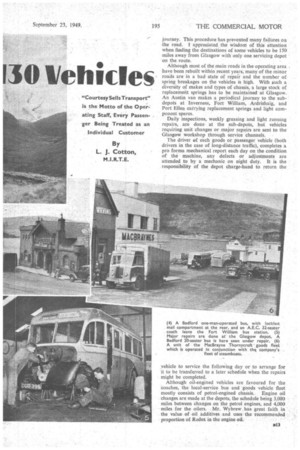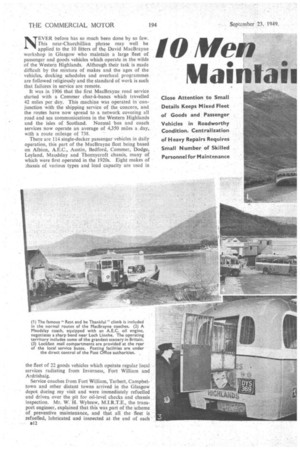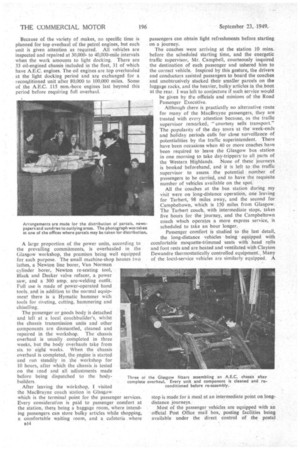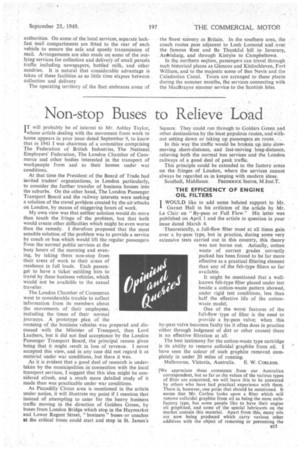130 Vehicles
Page 47

Page 46

Page 48

Page 49

If you've noticed an error in this article please click here to report it so we can fix it.
By L. J. Cotton,
M.I.R.T.E.
NEVER before has so much been done by so few. This near-Churchillian phrase may well be applied to the 10 fitters of the David MacBrayne workshop in Glasgow who maintain a large fleet of passenger and goods vehicles which operate in the wilds of the Western Highlands. Although their task is made difficult by the mixture of makes and the ages of the vehicles, docking schedules and overhaul programmes are followed religiously and the standard of work is such that failures in service are remote.
It was in 1906 that the first MacBrayne road service started with a Cornrner char-a-bancs which travelled 42 miles per day. This machine was operated in conjunction with the shipping service of the concern, and the routes have now spread to a network covering all road and sea communications in the Western Highlands and the isles of Scotland. Normal 'bus and coach services now operate an average of 4,350 miles a day, with a route mileage of 738.
There are 114 single-decker passenger vehicles in daily operation, this part of the MacBrayne fleet being based on Albion, A,E.C., Austin, Bedford, Commer, Dodge, Leyland, Maudslay and Thornycroft chassis, many of which were first operated in the 1920s. Eight makes of hassis of various types and load capacity are used in the fleet of 22 goods vehicles which operate regular local services radiating from Inverness, Fort William and Ardrishaig.
Service coaches from Fort William, Tarbert, Campbeltown and other distant towns arrived in the Glasgow depot during my visit and were immediately refuelled and driven over the pit for oil-level checks and chassis inspection. Mr. W. H. Wybrew, M.I.R.T.E., the transport engineer, explained that this was part of the scheme of preventive maintenance, and that all the fleet is refuelled, lubricated and inspected at the end of each B12
journey. This procedure has prevented many failures on the road. I appreciated the wisdom of this attention when finding the destinations of some vehicles to be 150 miles away from Glasgow with only one servicing depot on the route.
Although most of the main roads in the operating area have been rebuilt within recent years, many of the minor roads are in a bad state of repair and the number of spring breakages on the vehicles is high. With such a diversity of makes and types of chassis, a large stock of replacement springs has to be maintained at Glasgow. An Austin van makes a periodical journey to the subdepots at Inverness, Fort William, Ardrishaig, and Port Ellen carrying replacement springs and light component spares.
Daily inspections, weekly greasing and light running repairs, are done at the sub-depots, but vehicles requiring unit changes or major repairs are sent to the Glasgow workshop through service channels.
The driver of each goods or passenger vehicle (both drivers in the case of long-distance traffic), completes a pro forma mechanical report each day on the condition of the machine, any defects or adjustments are attended to by a mechanic on night duty. It is he responsibility of the depot charge-hand to return the vehicle to service the following day or to arrange for it to be transferred to a later schedule when the repairs might be completed.
Although oil-erigined vehicles are favoured for the coaches, the local-service bus and goods vehicle fleet
mostly consists of petrol-engined chassis. Engine oil changes are made at the depots, the schedule being 3,000 miles between changes on the petrol engines, and 4,000 miles for the oilers. Mr. Wybrew has great faith in the value of oil additives and uses the recommended proportion of Redex in the engine oil.
Because of the variety of makes, no specific time is planned for top overhaul of the petrol engines, but each unit is given attention as required. All vehicles are inspected and repaired at 30,000to 40,000-mile intervals when the work amounts to light docking. There are 33 oil-engined chassis included in the fleet, 31 of which have A.E.C. engines. The oil engines are top overhauled at the light docking period and are exchanged for a reconditioned unit after 80,000 to 100,000 miles. Sonic of the A.E.C. 115 mm.-bore engines last beyond this period before requiring full overhaul.
A large proportion of the power units, according to the prevailing commitments, is overhauled in the Glasgow workshop, the premises being well equipped for such purpose. The small machine-shop houses two lathes, a Newton line borer, Van Norman cylinder borer, Newton re-seating tool, Black and Decker valve refacer, a power saw, and a 300 amp. arc-welding outfit Full use is made of power-operated hand tools., and in addition to the normal equipment there is a Hymatic hammer with tools for riveting, cutting, hammering and chiselling.
The passenger or goods body is detached and left at a local coachbuilder's, whilst the chassis transmission units and other components are dismantled, cleaned and repaired in the workshop. The chassis overhaul is usually completed in three weeks, but the body overhauls take from six to eight weeks. When the chassis overhaul is completed, the engine is started and run steadily in the workshop for 10 hours, after which the chassis is tested on the road and all adjustments made before being dispatched to the bodybuilders.
After leaving the workshop, I visited the MacBrayne coach station in Glasgow which is the terminal point for the passenger services. Every consideration is paid to passenger comfort at the station, there being a baggage room, where intending passengers can store bulky articles while shopping, a comfortable waiting room, and a cafeteria where
Three o complete
passengers can obtain light refreshments before starting on a journey.
The coaches were arriving at the station 10 mins. before the scheduled starting time, and the energetic traffic supervisor, Mr. Campbell, courteously inquired the destination of each passenger and ushered him to the correct vehicle. Inspired by this gesture, the drivers and conductors assisted passengers to board the coaches and unobtrusively stacked their smaller parcels on the luggage racks, and the heavier, bulky articles in the.boot at the rear. I was left to conjecture if such service would be given by the officials and minions of the Road Passenger Exectitive.
Although there is practically no alternative route for many of the MacBrayne passengers, they are treated with every attention because, as the traffic supervisor remarked, " courtesy sells transport." The popularity of the day tours at the week-ends and holiday periods calls for close surveillance of potentialities by the traffic superintendent. There have been occasions when 40 or more coaches have been required to leave the Glasgow bus station in one morning to take day-trippers‘ to all parts of the Western Highlands. None of these journeys is booked beforehand, and it is left to the traffic supervisor to assess the potential number of passengers to be carried, and to have the requisite number of vehicles available on the spot: All the coaches at the bus station during my visit were on long-distance operation, one leaving for Tarbert, 98 miles away, and the second for Campbeltown, which is 150 miles from Glasgow. The Tarbert coach, with intermediate stops, takes five hours for the journey, and the Campbeltown coach which operates a more express service, is scheduled to take an hour longer.
Passenger comfort is studied to the last detail, the long-distance vehicles being • equipped with comfortable moquette-trimmed seats with head rolls and foot rests and are heated and ventilated with Clayton Dewandre thermostatically controlled equipment., Many of the local-service vehicles are similarly equipped. A
stop is made for a meal at an intermediate point on longdistance journeys.
Most of the passenger vehicles are equipped with an official Post Office mail box, posting facilities being available under the direct control of the postal
authorities. On some of the local services, separate lockfast mail compartments are fitted to the rear of each vehicle to ensure the safe and speedy transmission of mail. Arrangements are also made on some of the outlying services for collection and delivey of small parcels traffic including newspapers; bottled milk, and other sundries. It is natural that considerable advantage is taken of these facilities as so little time elapses between collection and delivery The operating territory of the fleet embraces some of the finest scenery in Britain. In the southern area, the coach routes pass adjacent to Loch Lomond and over the famous Rest and Be Thankful hill to Inverary, Arelrishaig, and through Kintyre to Campbeltown.
In the northern section, passengers can travel through such historical places as Glencoe and Kinlochleven, Fort William, and to the majestic scene of Ben Nevis and the Caledonian Canal Tours are arranged to these places during the summer months, the services connecting with the MacBrayne steamer service to the Scottish Isles.




























































































